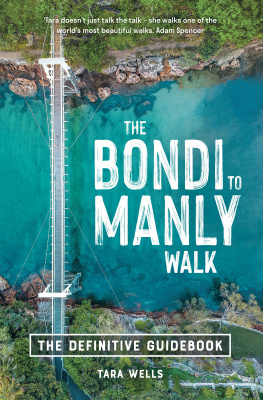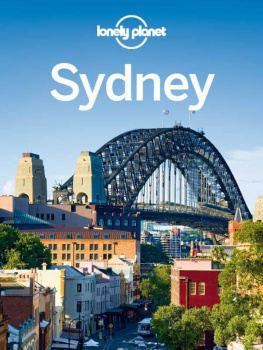T ARA W ELLS has spent the last decade writing about walking in Sydney for her blog Sydney Coast Walks. As a travel journalist she has written for Great Walks and international publications. This is her first book.
I love this book, and so will you.
This book is copyright. Apart from any fair dealing for the purpose of private study, research, criticism or review, as permitted under the Copyright Act, no part of this book may be reproduced by any process without written permission. Inquiries should be addressed to the publisher.
All reasonable efforts were taken to obtain permission to use copyright material reproduced in this book, but in some cases copyright could not be traced. The author welcomes information in this regard.
PART 1
PLANNING
PLAN YOUR WALK
INTRODUCTION TO THE WALK
A surfer crosses the path after catching a cheeky morning wave; children learn to sail, their boats bobbing in the harbour; and mates pull a kayak down to the waters edge for an afternoon paddle.
Sometimes there are no people at all; just scrubby coastal heath, delicate flannel flowers, and twisting Port Jackson figs, their buttress roots reaching into the earth. The cacophony of building construction is replaced by the insistent slap of water against rocky foreshore, or a gentle sigh of waves on sheltered harbour beaches. Gnarled Sydney red gums rusty orange and deep pink trunks frame the harbours aquamarine. Tawny frogmouths sleep in the trees overhead, waiting for night, and brush turkeys scratch among leaf litter below.
It is Sydney, but not the predictable bustle of commuters and commerce. This is the Bondi to Manly Walk, an 80-kilometre track gripping the citys coastline and putting its cliffs and beaches on glorious display.
The walk celebrates the contrast of a progressive city and protected bushland. The track offers expansive harbour views, juxtaposing ancient Aboriginal sites with modern harbourside homes. Connecting it all, a surprising amount of green: Sydney Harbour National Parks remnant bushland, disused military headland forts now turned back to nature and local pathways tracking through pockets of regenerated native plantings.
Beginning and ending at two of Sydneys most loved beaches, this is the walk to insist on for visitors, yet it also holds surprises for even the most familiar locals.
Despite its length, the Bondi to Manly Walk is accommodating. No matter how much time you have, how many kilometres you want to tread each day, whether the mission is a bunch of day walks or just one long multi-day inn-to-inn style walk the answer is yes.
And its a public transport dream. Although bus routes are never far away, its easy to pretend roads dont exist. Instead, break up the walk by ferry. Sydneys distinctive green and yellow ferries chug past enough trackside wharves to make this possible.
Like the walk itself, this guidebook aims to be more than the sum of its parts. It is a walk immersed in story, history and nature: the story of Sydney, its people and the land.
HOW HARD IS THE WALK?
People of most ages and fitness levels can complete the walk in sections. No bushwalking experience is required.
Assuming the route is broken into achievable distances, it varies between a Grade 2 and Grade 3 in the Australian Walking Track Grading System (the easiest is 1; the hardest is 5).
Most of the route keeps to formed paths and while signage for the walk itself is being improved nearby streets are usually clearly signposted. Expect gentle hills and a few steps just about everywhere. Some areas have short, steep hills (see Elevation below), many stairs, and, particularly in national park areas, uneven bush track.
ELEVATION

Use the Suggested itineraries (p. 10) along with the Distance summary (p. 12) to plan how to make the Bondi to Manly Walk work for you.
PERMITS
There are no charges or permits required to do the walk. Entry to Sydney Harbour National Park is also free with no permit required for hikers. Vehicle entry fees apply but along the route this essentially translates to a parking fee (see Parking p. 161).
ROUTE MARKER
 The official Bondi to Manly Walk has its own distinctive route marker, much like the Caminos symbolic scallop shell. The humpback whale, or burri burri in the Dharawal language, was chosen in collaboration with Aboriginal Land Councils for its local significance. The walks yellow and black symbol is drawn in the style of an Aboriginal rock engraving, and features footprints tracking across a whale. For more on Sydneys humpbacks see Whale watching p. 99.
The official Bondi to Manly Walk has its own distinctive route marker, much like the Caminos symbolic scallop shell. The humpback whale, or burri burri in the Dharawal language, was chosen in collaboration with Aboriginal Land Councils for its local significance. The walks yellow and black symbol is drawn in the style of an Aboriginal rock engraving, and features footprints tracking across a whale. For more on Sydneys humpbacks see Whale watching p. 99.
NORTH TO SOUTH, OR SOUTH TO NORTH?
This guidebook is written for walkers starting from the south, Bondi, and heading north, to Manly. With a bit of mental gymnastics, it can be used to walk in the opposite direction for an equally enjoyable experience. The difference is nuanced.
Ending the walk is more climactic at Manly: theres a sense of having left the city behind, and an already thrilling cross-harbour ferry ride is enhanced by seeing where youve walked. But ending at Bondi is also satisfying. As you stand on that iconic beach you know you have made it! Either direction offers multiple Harbour Bridge and Opera House vantage points for a Wow, Im going there feeling.

















 The official Bondi to Manly Walk has its own distinctive route marker, much like the Caminos symbolic scallop shell. The humpback whale, or burri burri in the Dharawal language, was chosen in collaboration with Aboriginal Land Councils for its local significance. The walks yellow and black symbol is drawn in the style of an Aboriginal rock engraving, and features footprints tracking across a whale. For more on Sydneys humpbacks see Whale watching p. 99.
The official Bondi to Manly Walk has its own distinctive route marker, much like the Caminos symbolic scallop shell. The humpback whale, or burri burri in the Dharawal language, was chosen in collaboration with Aboriginal Land Councils for its local significance. The walks yellow and black symbol is drawn in the style of an Aboriginal rock engraving, and features footprints tracking across a whale. For more on Sydneys humpbacks see Whale watching p. 99.